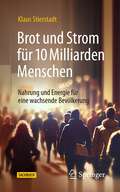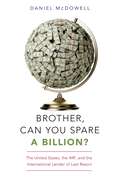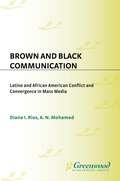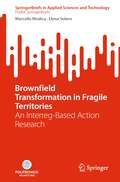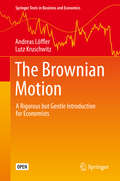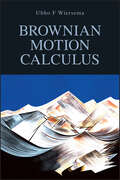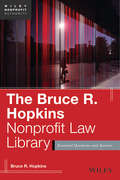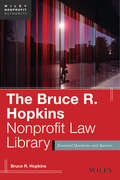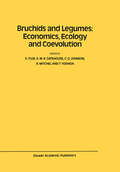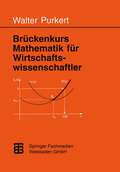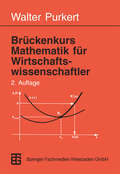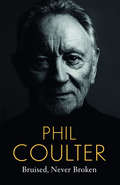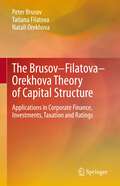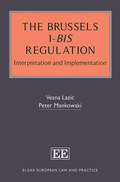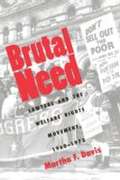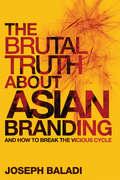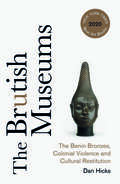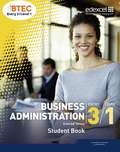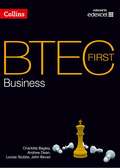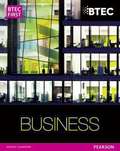- Table View
- List View
Brot und Strom für 10 Milliarden Menschen: Nahrung und Energie für eine wachsende Bevölkerung
by Klaus StierstadtWie lange liefert die Sonne genug Energie für unsere wachsende Bevölkerung?Reichen unsere Dächer aus, um genügend Solarstrom zu erzeugen?Stellen Pflanzen und Algen genug Nahrung und Sauerstoff für alle Lebewesen bereit?Millionen Menschen hungern. Strom ist für Milliarden Menschen ein Traum oder zumindest ein Luxusgut. Dieses Buch diskutiert mit Hilfe verständlich dargestellter Physik, wie weit es zu wenig Ressourcen gibt und wie weit es schlicht ein Problem der Verteilung ist.Das Buch ist gleichermaßen geeignet für Interessierte wie für Personen mit physikalischer Ausbildung. Zahlreiche Vergleiche und Erklärungen zeichnen ein anschauliches Bild, welches durch viele Abschätzungen und physikalische Details ergänzt wird.
Brother, Can You Spare a Billion?: The United States, the IMF, and the International Lender of Last Resort
by Daniel McDowellConventional wisdom says that the International Monetary Fund (IMF) functions as the de facto international lender of last resort (ILLR) for the global financial system. However, that premise is incomplete. Brother, Can You Spare a Billion? explores how the U.S. has for decades regularly complemented the Fund's ILLR role by selectively providing billions of dollars in emergency loans to foreign economies in crisis. Why would the U.S. ever put national financial resources at risk to "bail out" foreign countries? McDowell argues that the U.S. has been compelled to provide such rescues unilaterally when it believes the IMF's multilateral response is too slow or too small to protect vital U.S. economic interests. Through a combination of historical case studies and statistical analysis, McDowell uncovers the defensive motives behind U.S. decisions to provide global liquidity from the 1960s through the 2008 global financial crisis. Moving beyond conventional wisdom, this book paints a complete picture of how international financial crises have been managed and highlights the unique role the U.S. has played in stabilizing the world economy in troubled times.
Brother, Can You Spare a Billion?: The United States, the IMF, and the International Lender of Last Resort
by Daniel McDowellConventional wisdom says that the International Monetary Fund (IMF) functions as the de facto international lender of last resort (ILLR) for the global financial system. However, that premise is incomplete. Brother, Can You Spare a Billion? explores how the U.S. has for decades regularly complemented the Fund's ILLR role by selectively providing billions of dollars in emergency loans to foreign economies in crisis. Why would the U.S. ever put national financial resources at risk to "bail out" foreign countries? McDowell argues that the U.S. has been compelled to provide such rescues unilaterally when it believes the IMF's multilateral response is too slow or too small to protect vital U.S. economic interests. Through a combination of historical case studies and statistical analysis, McDowell uncovers the defensive motives behind U.S. decisions to provide global liquidity from the 1960s through the 2008 global financial crisis. Moving beyond conventional wisdom, this book paints a complete picture of how international financial crises have been managed and highlights the unique role the U.S. has played in stabilizing the world economy in troubled times.
Brown and Black Communication: Latino and African American Conflict and Convergence in Mass Media (Contributions to the Study of Mass Media and Communications)
by Diana Rios Ali MohamedThough Latinos and African Americans have lived together in large cities as neighbors, there is much that is still misunderstood between them. Those who live in non-diverse locales have only news and entertainment representations on which to base their information about the two cultures. This new collection of essays brings together the latest interdisciplinary works by scholars examining conflicts and convergences among Latinos and African Americans in mass-mediated and cross-cultural contexts. Contributions in the form of both empirical and critical ethnographic research present compelling works in cross-cultural relations, news, entertainment, news media, education, and community relations.^IBrown and Black Communication^R challenges those who do not think that significant projects and key research have been conducted on the two largest ethnic communities in the United States. Of certain appeal to both scholars and those with more applied needs in media, education, and public policy, this challenging collection offers a range of perspectives on two widely diverse bodies of American people.
Brownfield Transformation in Fragile Territories: An Interreg-Based Action Research (SpringerBriefs in Applied Sciences and Technology)
by Marcello Modica Elena SoleroThis book presents and critically evaluates the results of a European territorial cooperation project addressing the planning challenge of brownfield transformation in fragile territories. Set against the backdrop of the current scenario of deindustrialisation in the European Alps, the book describes how to read and interpret the spatial condition of industrial brownfields in peripheral mountain areas as complex transformation sites. Through key theoretical references, well-documented experiences and field activities, the book explores and advances an innovative methodology of design-based participatory planning conceived specifically for fragile socioeconomic and environmental contexts. The empirical basis for such a methodological exploration is provided by four pilot sites distributed between Austria, Italy, France and Slovenia, identified in the cooperation project as highly representative and recurring situations. The book includes a comparative review of the work carried out for the pilot sites, as well as the planning outcomes generated, providing a clear and operative reference for scholars, professionals and public officers called to face similar experiences.
Brownian Agents and Active Particles: Collective Dynamics in the Natural and Social Sciences (Springer Series in Synergetics)
by Frank SchweitzerThis book lays out a vision for a coherent framework for understanding complex systems. By developing the genuine idea of Brownian agents, the author combines concepts from informatics, such as multiagent systems, with approaches of statistical many-particle physics. It demonstrates that Brownian agent models can be successfully applied in many different contexts, ranging from physicochemical pattern formation to swarming in biological systems.
The Brownian Motion: A Rigorous but Gentle Introduction for Economists (Springer Texts in Business and Economics)
by Andreas Löffler Lutz KruschwitzThis open access textbook is the first to provide Business and Economics Ph.D. students with a precise and intuitive introduction to the formal backgrounds of modern financial theory. It explains Brownian motion, random processes, measures, and Lebesgue integrals intuitively, but without sacrificing the necessary mathematical formalism, making them accessible for readers with little or no previous knowledge of the field. It also includes mathematical definitions and the hidden stories behind the terms discussing why the theories are presented in specific ways.
Brownian Motion Calculus
by Ubbo F. WiersemaBrownian Motion Calculus presents the basics of Stochastic Calculus with a focus on the valuation of financial derivatives. It is intended as an accessible introduction to the technical literature. A clear distinction has been made between the mathematics that is convenient for a first introduction, and the more rigorous underpinnings which are best studied from the selected technical references. The inclusion of fully worked out exercises makes the book attractive for self study. Standard probability theory and ordinary calculus are the prerequisites. Summary slides for revision and teaching can be found on the book website.
The Bruce R. Hopkins Nonprofit Law Library: Essential Questions and Answers (Wiley Nonprofit Authority)
by Bruce R. HopkinsNeed a quick answer to a nonprofit legal conundrum? It’s literally at your fingertips with The Bruce R. Hopkins Nonprofit Law Library. Supplying you with find-it-on-the-run answers to your nonprofit law questions, this Library prepares you to meet and manage your nonprofit’s legal obligations with its step-by-step guidance. Packed with authoritative answers to the most essential questions on how to start a nonprofit organization; nonprofit law basics; maintenance of tax exemption; public charity rules; unrelated business rules; boards of directors and compensation; conflicts of interest; self-dealing; liability, and much more, this e-Library offers hands-on information mined from the following bestselling books and updated and expanded by the leading authority on nonprofit law, Bruce R. Hopkins: • Nonprofit Law for Religious Organizations: Essential Questions & Answers / Bruce R. Hopkins and David Middlebrook • 650 Essential Nonprofit Law Questions Answered / Bruce R. Hopkins • The Legal Answer Book for Private Foundations / Bruce R. Hopkins and Jody Blazek • Starting and Managing a Nonprofit Organization, Sixth Edition / Bruce R. Hopkins • Nonprofit Law for Colleges and Universities / Bruce R. Hopkins, Virginia C. Gross, and Thomas J. Schenkelberg From acquiring and maintaining tax-exempt status to fundraising regulation, The Bruce R. Hopkins Nonprofit Law Library gives you the legal guidance and practical insights you need—now.
The Bruce R. Hopkins Nonprofit Law Library: Essential Questions and Answers (Wiley Nonprofit Authority)
by Bruce R. HopkinsNeed a quick answer to a nonprofit legal conundrum? It’s literally at your fingertips with The Bruce R. Hopkins Nonprofit Law Library. Supplying you with find-it-on-the-run answers to your nonprofit law questions, this Library prepares you to meet and manage your nonprofit’s legal obligations with its step-by-step guidance. Packed with authoritative answers to the most essential questions on how to start a nonprofit organization; nonprofit law basics; maintenance of tax exemption; public charity rules; unrelated business rules; boards of directors and compensation; conflicts of interest; self-dealing; liability, and much more, this e-Library offers hands-on information mined from the following bestselling books and updated and expanded by the leading authority on nonprofit law, Bruce R. Hopkins: • Nonprofit Law for Religious Organizations: Essential Questions & Answers / Bruce R. Hopkins and David Middlebrook • 650 Essential Nonprofit Law Questions Answered / Bruce R. Hopkins • The Legal Answer Book for Private Foundations / Bruce R. Hopkins and Jody Blazek • Starting and Managing a Nonprofit Organization, Sixth Edition / Bruce R. Hopkins • Nonprofit Law for Colleges and Universities / Bruce R. Hopkins, Virginia C. Gross, and Thomas J. Schenkelberg From acquiring and maintaining tax-exempt status to fundraising regulation, The Bruce R. Hopkins Nonprofit Law Library gives you the legal guidance and practical insights you need—now.
Bruchids and Legumes: Proceedings of the Second International Symposium on Bruchids and Legumes (ISBL-2) held at Okayama (Japan), September 6–9, 1989 (Series Entomologica #46)
by K. Fujii A. M. R. Gatehouse C. D. Johnson R. Mitchel Teruhiko YoshidaIn 1980, the International Symposium on the Ecology of Bruchids Attacking Legumes (Pulses), organized by Dr. Labeyrie, was held at Tours, France. Since then, there has been tremendous progress in the area of Bruchid and Legume research. At the same time, as we face the problems of world-wide population explosion and food shortage, the importance of legumes as the world's major protein source is rapidly increasing, especial ly in tropical regions. Thus, it seemed appropriate to hold the Second Symposium in order to review the recent progress in the control of Bruchids and in the biology and ecology of Bruchids and legumes. This is an important part of the search for ways to integrate these fields with a common perspective. The Second International Symposium on Bruchids and Legumes (ISBL-II) was held in September 6-9, 1989 at Okayama, Japan under the joint auspices of the Japanese Society of Applied Entomology and Zoology and of the Foundation for Advancement of International Science. Significant contributions have originated in Japan on the study of Bruchid and legumes. Most notably, the study on population ecology by Professor S.
Brückenkurs Mathematik für Wirtschaftswissenschaftler
by Prof. Dr. PurkertStudierende der Volks- und Betriebswirtschaft haben heutzutage ein beträchtli ches Pensum an Mathematik zu absolvieren, und dieses Pensum wird in Zukunft mit Sicherheit nicht geringer werden. Andererseits sind Mathematik und ma thematische Statistik Fächer, die bei vielen Studierenden der Anfangssemester nicht sehr beliebt sind, ja sogar einer nicht geringen Zahl von ihnen erhebli che Schwierigkeiten bereiten. Viele dieser Schwierigkeiten beruhen erfahrungs gemäß darauf, daß der Schulstoff, der an der Universität oder Fachhochschule vorausgesetzt werden muß, nicht sicher beherrscht wird. Ein erstes Ziel dieses Brückenkurses besteht deshalb darin, kompakt und über sichtlich nochmals diejenigen Teile des Schulstoffes darzustellen, die für ein Stu dium der Volks- und Betriebswirtschaft besonders relevant sind. Es geht vor allem um sicheres Rechnen mit allgemeinen Zahlen sowie um den Funktions begriff, der als eines der wichtigsten theoretischen Werkzeuge zum Verständnis von Zusammenhängen im Mittelpunkt steht. Eine Brücke hat aber mindestens zwei Pfeiler, und so soll der Kurs gleichzeitig ein brauchbares Lehrbuch der Mathematik für die Anfangssemester sein. Ich habe mich bemüht, ein Buch auch für diejenigen Studierenden zu schreiben, für die Mathematik nicht gerade das Lieblingsfach ist. Es wurde deshalb Wert auf große Anschaulichkeit gelegt. Auf mathematische Strenge und auf Beweise, die zwar für den Mathematiker unerläßlich sind, für den Praktiker aber eine unnötige Belastung darstellen, wurde vollkommen verzichtet. Zahlreiche durch gerechnete Beispiele zeigen die Anwendung des Gelernten, und eine Fülle von Abbildungen soll auch das Vorstellungsvermögen anregen. Die Motivationen und Anwendungsbeispiele sind ausnahmslos dem wirtschaftswissenschaftlichen Bereich entnommen.
Brückenkurs Mathematik für Wirtschaftswissenschaftler
by Prof. Dr. PurkertStudierende der Volks-und Betriebswirtschaft haben heutzutage ein beträchtli ches Pensum an Mathematik zu absolvieren, und dieses Pensum wird in Zukunft mit Sicherheit nicht geringer werden. Andererseits sind Mathematik und ma thematische Statistik Fächer, die bei vielen Studierenden der Anfangssemester nicht sehr beliebt sind, ja sogar einer nicht geringen Zahl von ihnen erhebli che Schwierigkeiten bereiten. Viele dieser Schwierigkeiten beruhen erfahrungs gemäß darauf, daß der Schulstoff, der an der Universität oder Fachhochschule vorausgesetzt werden muß, nicht sicher beherrscht wird. Ein erstes Ziel dieses Brückenkurses besteht deshalb darin, kompakt und über sichtlich nochmals diejenigen Teile des Schulstoffes darzustellen, die für ein Stu dium der Volks- und Betriebswirtschaft besonders relevant sind. Es geht vor allem um sicheres Rechnen mit allgemeinen Zahlen sowie um den Funktions begriff, der als eines der wichtigsten theoretischen Werkzeuge zum Verständnis von Zusammenhängen im Mittelpunkt steht. Eine Brücke hat aber mindestens zwei Pfeiler, und so soll der Kurs gleichzeitig ein brauchbares Lehrbuch der Mathematik für die Anfangssemester sein. Ich habe mich bemüht, ein Buch auch für diejenigen Studierenden zu schreiben, für die Mathematik nicht gerade das Lieblingsfach ist. Es wurde deshalb Wert auf große Anschaulichkeit gelegt. Auf mathematische Strenge und auf Beweise, die zwar für den Mathematiker unerläßlich sind, für den Praktiker aber eine unnötige Belastung darstellen, wurde vollkommen verzichtet. Zahlreiche durch gerechnete Beispiele zeigen die Anwendung des Gelernten, und eine Fülle von Abbildungen soll auch das Vorstellungsvermögen anregen. Die Motivationen und Anwendungsbeispiele sind ausnahmslos dem wirtschaftswissenschaftlichen Bereich entnommen.
Bruised, Never Broken
by Phil CoulterAs the composer of some of Ireland’s best-loved songs, not to mention a host of global hits, Phil Coulter has been a mainstay of Irish cultural life for decades. But this is a position that has been hard won, often in the face of extraordinary personal and political upheaval, most of which has, to date, been kept hidden from public view.Heartfelt and wry, meditative and entertaining, Bruised, Never Broken is the story of the author’s remarkable rise from modest beginnings on the streets of post-war Derry to the summit of the global charts, as a composer and confidante to a host of the era’s biggest stars, such as Van Morrison, Luke Kelly, Cliff Richard and Sandie Shaw.Poignantly, it is also a hymn to the place that made him, a city as complex and troubled throughout Ireland’s middle decades as any on Earth, yet a source of constant inspiration and consolation.
The Brusov–Filatova–Orekhova Theory of Capital Structure: Applications in Corporate Finance, Investments, Taxation and Ratings
by Peter Brusov Tatiana Filatova Natali OrekhovaThe book introduces and discusses the modern theory of the cost of capital and capital structure - the BFO theory (Brusov-Filatova-Orekhova theory), which is valid for companies of arbitrary age and which replaced the theory of Nobel laureates Modigliani and Miller. The theory takes into account the conditions faced by companies operating in the real economy, such as revenue fluctuations; the arbitrary frequency of tax on profit payments (monthly, quarterly, semi-annual or annual payments), both for advance income tax payments and for payments at the end of the respective period; and the arbitrary frequency of interest on loans payments. The impact of these conditions on the company value, on the cost of raising capital, on the company's dividend policy and managerial decisions are discussed. The book subsequently develops new applications of the BFO theory in several areas such as corporate finance, corporate governance, investments, taxation, business valuations and ratings.
The Brussels I-bis Regulation: Interpretation and Implementation (Elgar European Law and Practice series)
by Vesna Lazić Peter MankowskiThe Brussels I-bis Regulation remains the most significant legal instrument for procedural law in the EU, providing the cornerstone for questions of international jurisdiction and enforcement of judgments in civil and commercial matters. This authoritative book provides a thorough and practical analysis of the Regulation, with particular focus on its implementation and application.With comprehensive coverage of the relevant CJEU case law, and rigorous analysis of the jurisprudence of the Brussels Regulation, this book acts as both a detailed reference work for the understanding and practical application of the Regulation, and a roadmap for its future. It highlights the challenges involved in the application of the Regulation, such as interpretation of its concepts and the achievement of its underlying purposes, as well as the efficiency and potential costs, and provides suggestions for legislative improvements.Key Features:A focus on the interpretation and practical application of the RegulationDetailed analysis of the case law and jurisprudenceHighlights both deficiencies and potential improvementsWritten by leading scholars in EU and Private International LawThe Brussels I-bis Regulation is an important reference work for practitioners handling cross-border commercial or civil cases. It is also an invaluable educational and research tool for scholars in the fields of EU Law, private international law and commercial law.
Brutal Need: Lawyers And The Welfare Rights Movement, 1960-1973 (PDF)
by Martha F. DavisDuring the 1960s a new breed of "poverty lawyers"-in collaboration with welfare recipient activists-mounted a legal campaign to create a constitutional right to welfare. The collaboration worked significant changes in the social welfare system of the United States and in the scope of individual constitutional rights. In this first in-depth account, Martha F. Davis tells the behind-the-scenes story of the strategies, successes, failures, and frustrations of that important campaign. "[A] succinct and elegant book, Brutal Need enriches today's impoverished discussion of welfare reform."-Linda Gordon, Nation "In lucid prose, Davis tells the compelling story of the sometimes difficult but inspiring and pioneering 1960s alliance between lawyers and welfare rights activists. This book is both a good read and good history."-Frances Fox Piven, coauthor of Regulating the Poor: The Functions of Public Welfare "Brutal Need is a magnificent book. It combines sophisticated analysis of legal principles defining the rights of the poor, a rich social history of the organization of poor people in the 1960s, and gripping biographies of the leading participants in the often neglected social movement. It is a pleasure to read this lucid book. Davis provides insight, even to a person who participated in the events she describes."-Sylvia Law, New York University School of Law "An accurate, informative, and highly readable book on a fascinating topic."-Shep Melnick, Brandeis University Winner of a 1994 American Bar Association Certificate of Merit Award
Brutal Need (PDF): Lawyers And The Welfare Rights Movement, 1960-1973
by Martha F. DavisDuring the 1960s a new breed of "poverty lawyers"-in collaboration with welfare recipient activists-mounted a legal campaign to create a constitutional right to welfare. The collaboration worked significant changes in the social welfare system of the United States and in the scope of individual constitutional rights. In this first in-depth account, Martha F. Davis tells the behind-the-scenes story of the strategies, successes, failures, and frustrations of that important campaign. "[A] succinct and elegant book, Brutal Need enriches today's impoverished discussion of welfare reform."-Linda Gordon, Nation "In lucid prose, Davis tells the compelling story of the sometimes difficult but inspiring and pioneering 1960s alliance between lawyers and welfare rights activists. This book is both a good read and good history."-Frances Fox Piven, coauthor of Regulating the Poor: The Functions of Public Welfare "Brutal Need is a magnificent book. It combines sophisticated analysis of legal principles defining the rights of the poor, a rich social history of the organization of poor people in the 1960s, and gripping biographies of the leading participants in the often neglected social movement. It is a pleasure to read this lucid book. Davis provides insight, even to a person who participated in the events she describes."-Sylvia Law, New York University School of Law "An accurate, informative, and highly readable book on a fascinating topic."-Shep Melnick, Brandeis University Winner of a 1994 American Bar Association Certificate of Merit Award
The Brutal Truth About Asian Branding: And How to Break the Vicious Cycle
by Joseph BaladiThis is one of the most thoughtful books on branding I've come across. Most such books are either quickly-crafted "how-to" books or academic tomes over-burdened with references. This book is thoughtful because it raises questions which deal with the "why" rather than just "how" of branding. The reference to brutal truth as the truth which will set us free—to examine ourselves without self-illusions—is liberating. The notion that Asia has many good, but no great brands, is also not a put-down but a clarion call for Asian CEOs to rise to the challenge and create lasting, meaningful, committed brands. Ho Kwon Ping Chairman/CEO, Banyan Tree and Board of Trustees, SMU 2010 recipient of the "Lifetime Achievement Award" by the American Creativity Association A cold shower to wake people up. Joe Baladi's Brand Blueprint is a great tool for anyone involved in Sovereign Relationship Marketing or brand building anywhere. Timothy Love Vice Chairman Chief Executive Officer, Omnicom APIMA There are many books about branding but few address Asian companies directly. Joe Baladi has been one of the loudest voices to advocate strong branding practices to Asian companies determined to outperform their competitors. The Brutal Truth About Asian Branding is a timely book that all Asian CEOs with global aspirations should read. Richard Eu Group CEO, Eu Yan Sang International The Brutal Truth About Asian Branding is the first book that connects branding frameworks to the realities of operating in Asia. It offers a very straightforward perspective on the challenges Asian CEOs face as they build their businesses and their brands, and perhaps the most compelling part of the book is the passionate plea for how Asian CEOs should be thinking different about branding. In true Baladi style, it is straight from the heart. Maarten Kelder Managing Partner (Asia), Monitor Group A very interesting and valuable perspective on Asian branding... one that decision makers in the region should read and embrace. Well done Joe! Ron Sim Founder & CEO, OSIM International Brands mean Business, anywhere in the world! The focus on Asia, at this time, is natural since the developing nations of the region did so much to help the world recover from the global 2008 economic crisis. Baladi’s text is timely; it is thoughtful and thought-provoking; putting people and brands center stage with practical insights borne of his breadth of personal experience at the frontline. Chris D. Beaumont Professor, Tokyo University, Global Centre of Excellence Director, North Asia, Results International The brutal truth is that Joe Baladi is right. Asian CEOs must learn the brand skills used so successfully in the rest of the world. It will take a big change in mentality, but the rewards will be vast. This book is a great start to that revolution. Michael Newman Author, 22 Irrefutable Laws of Advertising
The Brutal Truth About Asian Branding: And How to Break the Vicious Cycle
by Joseph BaladiThis is one of the most thoughtful books on branding I've come across. Most such books are either quickly-crafted "how-to" books or academic tomes over-burdened with references. This book is thoughtful because it raises questions which deal with the "why" rather than just "how" of branding. The reference to brutal truth as the truth which will set us free—to examine ourselves without self-illusions—is liberating. The notion that Asia has many good, but no great brands, is also not a put-down but a clarion call for Asian CEOs to rise to the challenge and create lasting, meaningful, committed brands. Ho Kwon Ping Chairman/CEO, Banyan Tree and Board of Trustees, SMU 2010 recipient of the "Lifetime Achievement Award" by the American Creativity Association A cold shower to wake people up. Joe Baladi's Brand Blueprint is a great tool for anyone involved in Sovereign Relationship Marketing or brand building anywhere. Timothy Love Vice Chairman Chief Executive Officer, Omnicom APIMA There are many books about branding but few address Asian companies directly. Joe Baladi has been one of the loudest voices to advocate strong branding practices to Asian companies determined to outperform their competitors. The Brutal Truth About Asian Branding is a timely book that all Asian CEOs with global aspirations should read. Richard Eu Group CEO, Eu Yan Sang International The Brutal Truth About Asian Branding is the first book that connects branding frameworks to the realities of operating in Asia. It offers a very straightforward perspective on the challenges Asian CEOs face as they build their businesses and their brands, and perhaps the most compelling part of the book is the passionate plea for how Asian CEOs should be thinking different about branding. In true Baladi style, it is straight from the heart. Maarten Kelder Managing Partner (Asia), Monitor Group A very interesting and valuable perspective on Asian branding... one that decision makers in the region should read and embrace. Well done Joe! Ron Sim Founder & CEO, OSIM International Brands mean Business, anywhere in the world! The focus on Asia, at this time, is natural since the developing nations of the region did so much to help the world recover from the global 2008 economic crisis. Baladi’s text is timely; it is thoughtful and thought-provoking; putting people and brands center stage with practical insights borne of his breadth of personal experience at the frontline. Chris D. Beaumont Professor, Tokyo University, Global Centre of Excellence Director, North Asia, Results International The brutal truth is that Joe Baladi is right. Asian CEOs must learn the brand skills used so successfully in the rest of the world. It will take a big change in mentality, but the rewards will be vast. This book is a great start to that revolution. Michael Newman Author, 22 Irrefutable Laws of Advertising
The Brutish Museums: The Benin Bronzes, Colonial Violence and Cultural Restitution
by Dan HicksWalk into any European museum today and you will see the curated spoils of Empire. They sit behind plate glass: dignified, tastefully lit. Accompanying pieces of card offer a name, date and place of origin. They do not mention that the objects are all stolen. Few artefacts embody this history of rapacious and extractive colonialism better than the Benin Bronzes - a collection of thousands of metal plaques and sculptures depicting the history of the Royal Court of the Obas of Benin City, Nigeria. Pillaged during a British naval attack in 1897, the loot was passed on to Queen Victoria, the British Museum and countless private collections. The story of the Benin Bronzes sits at the heart of a heated debate about cultural restitution, repatriation and the decolonisation of museums. In The Brutish Museum, Dan Hicks makes a powerful case for the urgent return of such objects, as part of a wider project of addressing the outstanding debt of colonialism.
The Brutish Museums: The Benin Bronzes, Colonial Violence and Cultural Restitution
by Dan HicksWalk into any European museum today and you will see the curated spoils of Empire. They sit behind plate glass: dignified, tastefully lit. Accompanying pieces of card offer a name, date and place of origin. They do not mention that the objects are all stolen. Few artefacts embody this history of rapacious and extractive colonialism better than the Benin Bronzes - a collection of thousands of metal plaques and sculptures depicting the history of the Royal Court of the Obas of Benin City, Nigeria. Pillaged during a British naval attack in 1897, the loot was passed on to Queen Victoria, the British Museum and countless private collections. The story of the Benin Bronzes sits at the heart of a heated debate about cultural restitution, repatriation and the decolonisation of museums. In The Brutish Museum, Dan Hicks makes a powerful case for the urgent return of such objects, as part of a wider project of addressing the outstanding debt of colonialism.
BTEC Entry 3/Level 1 Business Administration: Student Book
by Conrad TetleyDesigned for the needs of the Entry 3/Level 1 learner in full colour, with a spread-based approach, and topics broken into clear, bite-sized chunks to retain learners attention. Lively activities, mini case studies and clear checklists and summaries help learners engage with - and remember - content. Extensive coverage with 11 Level 1 units and 2 Entry Level 3 units enough for a Level 1 Diploma - so learners can be confident they have the content they need to achieve their qualification. Edexcel's own Assignment tips, written by BTEC experts, help learners to achieve their potential in assessments. Activities mapped to the assessment criteria in each unit, provide support and clear direction for learners, helping them to work towards the criteria. Prepares learners for employment with a focus on employability skills and learning through work contexts. Helps learners progress to BTEC Level 2 First by building their confidence with the style of BTEC qualifications.
BTEC First Business: Student Book (PDF)
by Charlotte Bagley John Bevan Andrews Deans Louise StubbsBTEC First Business is a brand new textbook for the revised 2012 specification.
BTEC First Business: student book (PDF)
by Lisa Chandler-Corris Mike Neild Carol Carysforth Karen GlencrossResources designed to support learners of the new next generation BTEC First in Business specification*. Covers three mandatory units and a wide selection of optional units. Each unit of the Student Book is presented in topics to ensure the content is accessible and engaging for learners. Covers all the underpinning knowledge and understanding needed at level 2 to ensure that learners are fully prepared for this course. Activities in each unit provide support and clear direction for learners and can be used in the classroom or for independent work. New Assessment Zone guides learners through both internal and external assessment. Practice assignments and assessment guidance will help learners to achieve their potential in internally assessed units. * From 2012, Pearson Education's BTEC First qualifications have been under re-development, so schools and colleges could be teaching the existing 2010 specification or the new next generation 2012-2013 specification. There are different Student Books to support each specification. If learners are unsure, they should check with their teacher or tutor.
